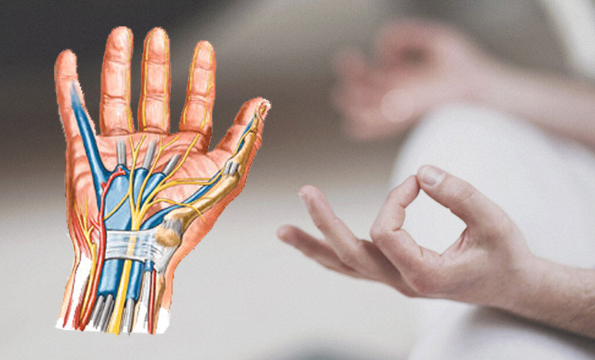Damage to the nerve that takes information (Sensory) from the hand to the brain and also from the brain (motor) with the hand blades to Carpel tunnel syndrome. The condition is characterized by tingling, pain, numbness and weakness in the palm and figures, which could vary from mild discomfort to severe disability incapacitating you from using the hands. This condition occurs due to the swelling of the nerve (median nerve) which is passing under a narrow passage in front of wrist. This passage is called a Carpel Tunnel; ‘carpel’ refers to the small bones which join together to form the wrist joint and ‘tunnel’ to the passage formed by tough non elastic ligament attached to these bone like a bridge. The median nerve passes through this passage under the bridge. Of course there is enough soft tissue around this nerve so that the nerve well protected when the wrist moves in different direction. In carpel tonal syndrome due to excessive repetitive movement of the fingers, hands and wrist (under emotional stress & speed). Inflammation and swelling takes place under this bridge. Due to the swelling of the covering layer of the tendons and the soft tissues. In the limited space the narrow passage through which the nerve has to pass through becomes narrower. This causes pressure on the median nerve and the minute branches of arteries that supply oxygenated blood to the nerve itself. Hence the symptoms of pain, tingling, numbness and weakness are all nothing but the cry of the sensory and motor nerve files for more oxygen and freedom from entrapment.
How does stress aggravate this entrapment?
Emotional or psychological stress is contributes to the aggravation of carpel tunnel syndrome in two ways.- The excessive muscle work and constant state of partial contraction of muscles all over body in general and muscles of the part which is under constant usage in particular is a well known leads to further reduction in local blood flow effect we see during emotional stress. This to the median nerve in the wrist tunnel.
- The inflammatory process is disturbed and exaggerated by chemical imbalances that occur in the body during stress.
What are the yoga practices for couple tunnel syndrome?
The entrapment can be reduced through local deep rest and relaxation to the affected wrist area by applying the techniques of integrated approach of yoga therapy. The local practice include Sukshma Vyasamas for fingers, wrists, elbows and shoulders, practiced in slow easy effortless women with deep internal awareness and deep breathing. Each set of movement has to be followed by deep relaxation to the part by local DRT as the arm rests on the table or bed in sitting or supine postures respectively. The asanas to be avoided include all those practices that may increase pain due to over stretching of the wrist or weight bearing on the hands. Hence avoid Suryanamaskar, Bhujangasana, Sarvangasana & halasana or Sirsana. The component of reduction of the over all tension in the muscles all over the body is to be achieved by a basic set of 4 standing and 4 sitting postures followed by deep rest in shavasana. Pranayama with emphasis on Nadisuddhi practiced 4 times a day for 15 minutes each time goes a long way. Nadanusandhana to feel the deep internal massage effect of the chanting can be very effective tool to reduce the swelling and tightness under the carpel tunnel. Emotions management and stress reduction through Yama, Niyama, Bhakti Yoga, Jnana Yoga and Jnana Yoga constitute the major component of the holistic approach in yoga therapy.
SETU BANDHA SARVANGASANA
Setu means a bridge and Setu Bandha means the formation or construction of a bridge. In this position, the body is arched and supported on the shoulders, soles and heels. The arch is supported by the hands at the wrist.
Technique
- Do Salamba Sarvangasana
- Rest the palm well on the back, raise the spine up, take the legs back straight or bend the knees and throw the legs back over the wrists to the floor. Stretch out legs and keep them together.
- The whole body forms a bridge, the right of which is borne by the elbows and wrists. The only parts of the body in contact with the ground will be the back of the head and neck, the shoulders, the elbows and the feet. Stay in the pose from half a minute to a minute with normal breathing.
- It is possible to lessen the pressure on the elbows and the wrists by stretching the spine towards the neck, keeping the heels firmly on the ground.
Disclaimer
Yoga Ayurveda Therapy is Complementary Medicine and doesn't alternates any conventional treatment.
Yoga-Ayurveda Therapy needs physical assistance which may need physical touch. You can ask teacher or therapist not to give physical touch or assistance and based on whatever you choose, our teacher or therapist will follow the instructions. Any point you want to change the preference, then please inform teacher or therapist and management in writing. You will take responsibility of your decision and will not hold Union Yoga Ayurveda responsible for any kind of damage.
All kind of Yoga Ayurveda teaching and therapy can cause certain injuries and you are accepting those injuries. Signing up for the therapy or yoga courses means that you are aware of the probable injuries.
Union Yoga Ayurveda (Union Centre Pte Ltd) and its staff are not liable or responsible for any injuries caused during the session which are visible or not visible, physical or hormonal or mental. You as client take full responsibility of your own decision and will not claim any kind of compensation in terms of money or any resources for the damage caused because of due process.

